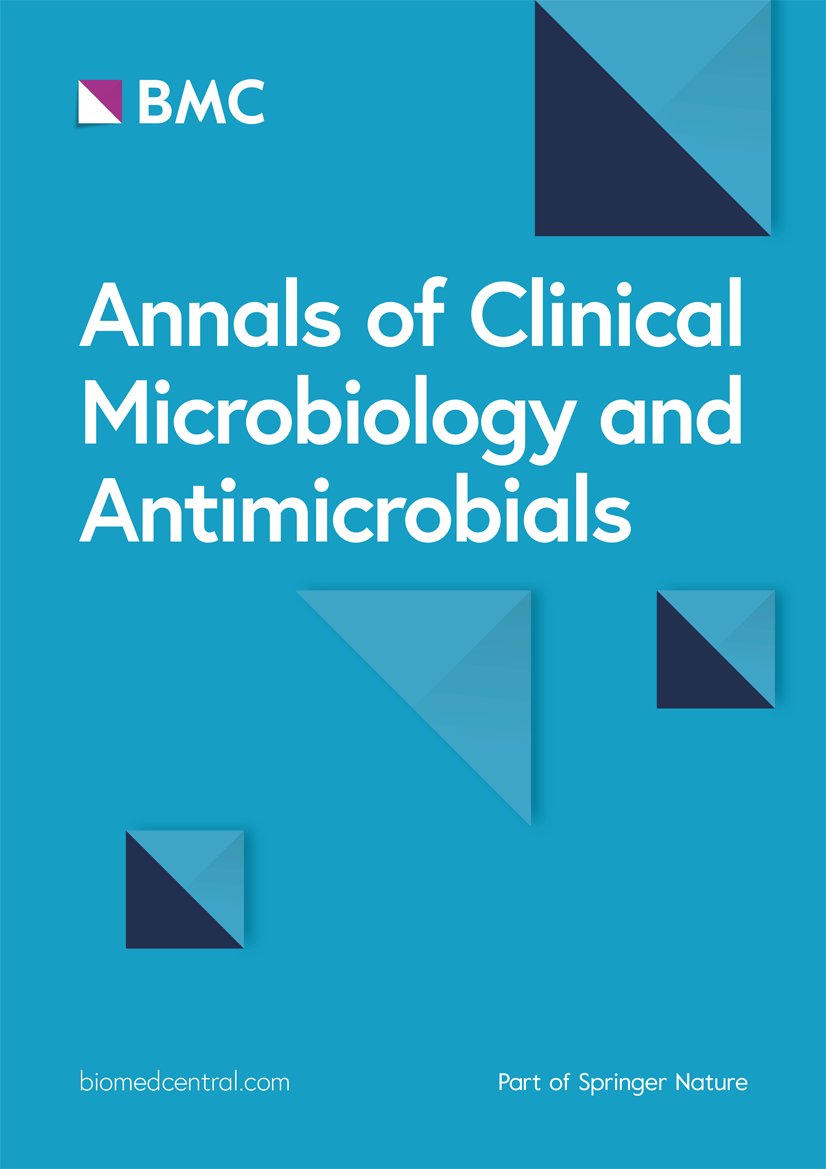Clinical manifestations, antimicrobial resistance and genomic feature analysis of multidrug-resistant Elizabethkingia strains
IF 4.6
2区 医学
Q1 MICROBIOLOGY
Annals of Clinical Microbiology and Antimicrobials
Pub Date : 2024-04-10
DOI:10.1186/s12941-024-00691-6
引用次数: 0
Abstract
Elizabethkingia is emerging as an opportunistic pathogen in humans. The aim of this study was to investigate the clinical epidemiology, antimicrobial susceptibility, virulence factors, and genome features of Elizabethkingia spp. Clinical data from 71 patients who were diagnosed with Elizabethkingia-induced pneumonia and bacteremia between August 2019 and September 2021 were analyzed. Whole-genome sequencing was performed on seven isolates, and the results were compared with a dataset of 83 available Elizabethkingia genomes. Genomic features, Kyoto Encyclopedia of Genes and Genomes (KEGG) results and clusters of orthologous groups (COGs) were analyzed. The mean age of the patients was 56.9 ± 20.7 years, and the in-hospital mortality rate was 29.6% (21/71). Elizabethkingia strains were obtained mainly from intensive care units (36.6%, 26/71) and emergency departments (32.4%, 23/71). The majority of the strains were isolated from respiratory tract specimens (85.9%, 61/71). All patients had a history of broad-spectrum antimicrobial exposure. Hospitalization for invasive mechanical ventilation or catheter insertion was found to be a risk factor for infection. The isolates displayed a high rate of resistance to cephalosporins and carbapenems, but all were susceptible to minocycline and colistin. Genomic analysis identified five β-lactamase genes (blaGOB, blaBlaB, blaCME, blaOXA, and blaTEM) responsible for β-lactam resistance and virulence genes involved in stress adaptation (ureB/G, katA/B, and clpP), adherence (groEL, tufA, and htpB) and immune modulation (gmd, tviB, cps4J, wbtIL, cap8E/D/G, and rfbC). Functional analysis of the COGs revealed that “metabolism” constituted the largest category within the core genome, while “information storage and processing” was predominant in both the accessory and unique genomes. The unique genes in our 7 strains were mostly enriched in KEGG pathways related to microRNAs in cancer, drug resistance (β-lactam and vancomycin), ABC transporters, biological metabolism and biosynthesis, and nucleotide excision repair mechanisms. The Elizabethkingia genus exhibits multidrug resistance and carries carbapenemase genes. This study presents a comparative genomic analysis of Elizabethkingia, providing knowledge that facilitates a better understanding of this microorganism.耐多药伊丽莎白金格菌株的临床表现、抗菌药耐药性和基因组特征分析
伊丽莎白金丝菌正在成为人类的一种机会性病原体。本研究旨在调查伊丽莎白金丝菌的临床流行病学、抗菌药敏感性、毒力因子和基因组特征。 研究人员分析了2019年8月至2021年9月期间确诊为伊丽莎白金丝菌引起的肺炎和菌血症的71名患者的临床数据。对 7 个分离株进行了全基因组测序,并将测序结果与现有的 83 个伊丽莎白金丝菌基因组数据集进行了比较。分析了基因组特征、京都基因与基因组百科全书(KEGG)结果和同源群(COG)。患者的平均年龄为(56.9 ± 20.7)岁,院内死亡率为 29.6%(21/71)。伊丽莎白金菌菌株主要来自重症监护室(36.6%,26/71)和急诊科(32.4%,23/71)。大多数菌株是从呼吸道标本中分离出来的(85.9%,61/71)。所有患者均有广谱抗菌药物接触史。住院进行有创机械通气或插入导管是感染的一个风险因素。分离菌株对头孢菌素类和碳青霉烯类耐药率较高,但对米诺环素和可乐定均敏感。基因组分析确定了五个β-内酰胺酶基因(blaGOB、blaBlaB、blaCME、blaOXA 和 blaTEM)对β-内酰胺耐药,以及参与应激适应(ureB/G、katA/B 和 clpP)、粘附(groEL、tufA 和 htpB)和免疫调节(gmd、tviB、cps4J、wbtIL、cap8E/D/G 和 rfbC)的毒力基因。对 COGs 的功能分析显示,"新陈代谢 "是核心基因组中最大的类别,而 "信息存储和处理 "则在附属基因组和独特基因组中占主导地位。7 个菌株中的独特基因大多富集在与癌症中的微小核糖核酸、耐药性(β-内酰胺和万古霉素)、ABC 转运体、生物代谢和生物合成以及核苷酸切除修复机制有关的 KEGG 通路中。伊丽莎白金丝菌属具有多药耐药性并携带碳青霉烯酶基因。本研究对伊丽莎白金丝菌进行了基因组比较分析,为更好地了解这种微生物提供了知识。
本文章由计算机程序翻译,如有差异,请以英文原文为准。
求助全文
约1分钟内获得全文
求助全文
来源期刊

Annals of Clinical Microbiology and Antimicrobials
MICROBIOLOGY-
CiteScore
8.60
自引率
0.00%
发文量
49
审稿时长
>12 weeks
期刊介绍:
Annals of Clinical Microbiology and Antimicrobials considers good quality, novel and international research of more than regional relevance. Research must include epidemiological and/or clinical information about isolates, and the journal covers the clinical microbiology of bacteria, viruses and fungi, as well as antimicrobial treatment of infectious diseases.
Annals of Clinical Microbiology and Antimicrobials is an open access, peer-reviewed journal focusing on information concerning clinical microbiology, infectious diseases and antimicrobials. The management of infectious disease is dependent on correct diagnosis and appropriate antimicrobial treatment, and with this in mind, the journal aims to improve the communication between laboratory and clinical science in the field of clinical microbiology and antimicrobial treatment. Furthermore, the journal has no restrictions on space or access; this ensures that the journal can reach the widest possible audience.
 求助内容:
求助内容: 应助结果提醒方式:
应助结果提醒方式:


